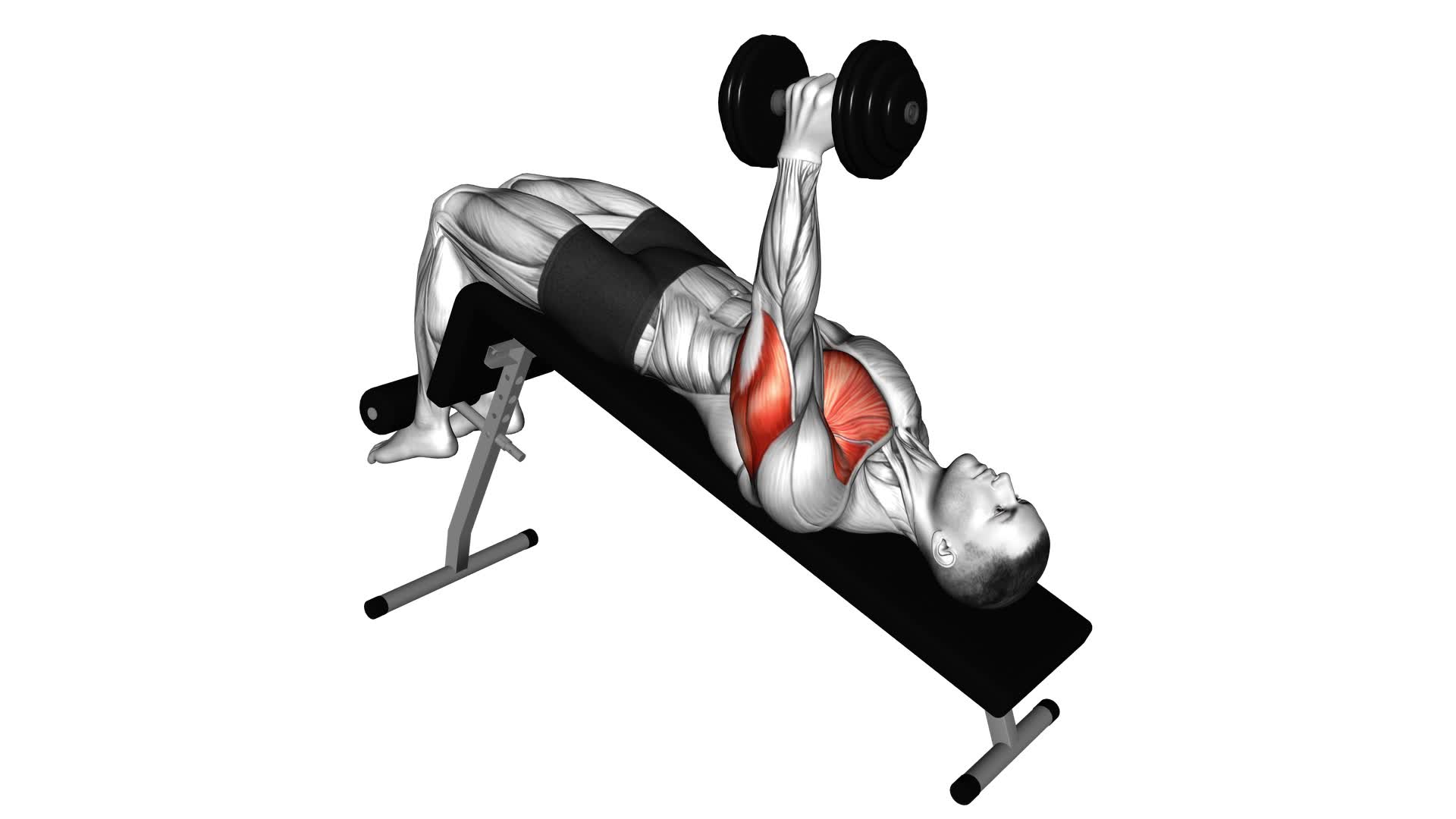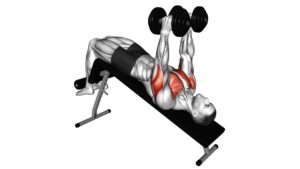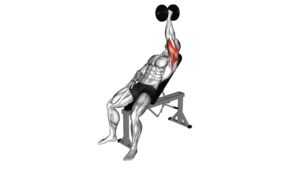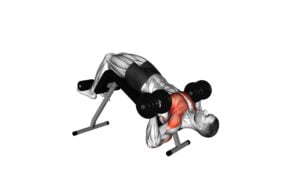Dumbbell Decline One Arm Hammer Press – Video Exercise Guide & Tips

Are you looking to strengthen your upper body and build impressive chest muscles? The dumbbell decline one arm hammer press is the perfect exercise for you.
Watch This Exercise Video
In this video exercise guide, we will show you the proper form and technique to execute this exercise effectively. We'll also provide variations and modifications to keep your workouts challenging and help you avoid common mistakes.
Follow our tips for maximal results and get ready to take your fitness to the next level.
Let's get started!
Key Takeaways
- Dumbbell Decline One Arm Hammer Press enhances strength and stability.
- It targets chest muscles, specifically pectoralis major and minor, and triceps.
- It increases muscle activation in the lower chest.
- It is effective for building mass and definition.
Benefits of Dumbbell Decline One Arm Hammer Press
You will experience enhanced strength and stability with the Dumbbell Decline One Arm Hammer Press. This exercise is great for targeting your chest muscles, specifically the pectoralis major and minor, as well as your triceps. The decline angle of the bench increases the muscle activation in your lower chest, making it a highly effective exercise for building mass and definition in that area.
To perform the Dumbbell Decline One Arm Hammer Press, you'll need a decline bench and a pair of dumbbells. Start by lying on the bench with your feet secured at the top and your back flat against the pad. Hold a dumbbell in one hand, with your palm facing inward. Slowly lower the dumbbell towards the center of your chest, keeping your elbow close to your body. Press the dumbbell back up to the starting position, focusing on squeezing your chest muscles.
This exercise not only targets your chest and triceps, but it also engages your core muscles to maintain stability on the decline bench. By incorporating the Dumbbell Decline One Arm Hammer Press into your workout routine, you can achieve greater muscle activation and overall strength and stability in your upper body.
Proper Form and Technique
Maintaining proper form and technique is crucial when performing the Dumbbell Decline One Arm Hammer Press exercise. By ensuring that you execute the exercise correctly, you can minimize the risk of injury and maximize muscle activation.
To prevent injuries, it's important to start with an appropriate weight that you can handle comfortably. Keep your core engaged and maintain a neutral spine throughout the movement. Avoid locking your elbows at the top of the press to prevent strain on the joints.
Focus on controlled movements and avoid using momentum to lift the weight. By keeping a slow and controlled pace, you can effectively activate the muscles in your chest, shoulders, and triceps. Remember to breathe throughout the exercise, exhaling as you press the weight up and inhaling as you lower it down.
With proper form and technique, you can optimize your results and minimize the risk of injury.
Now that you understand the importance of maintaining proper form and technique, let's move on to discussing variations and modifications of the Dumbbell Decline One Arm Hammer Press.
Variations and Modifications
To explore different ways to challenge and customize your workout, let's now delve into variations and modifications of the Dumbbell Decline One Arm Hammer Press exercise. By incorporating these variations and modifications, you can target different muscle groups and enhance muscle activation. Here are some options to consider:
- Use different equipment: Instead of using dumbbells, you can try using kettlebells or resistance bands to add variety to your workout. These alternative equipment options can provide a different type of resistance and engage your muscles in a slightly different way.
- Modify the angle: Changing the angle of decline can have a significant impact on muscle activation. You can experiment with different decline angles to target specific areas of your chest and shoulders. A steeper decline will put more emphasis on your upper chest, while a gentler decline will target your lower chest.
- Adjust grip position: Altering your grip position can also change the muscle activation during the exercise. You can try using a neutral grip, where your palms face each other, or a pronated grip, where your palms face away from your body. These variations can shift the focus between your chest, shoulders, and triceps.
Common Mistakes to Avoid
One key aspect to focus on when performing the Dumbbell Decline One Arm Hammer Press is proper form. It's crucial to avoid common mistakes and prioritize the importance of proper technique.
One common mistake is using too much weight. It's important to start with a weight that allows you to maintain proper form throughout the exercise. Using excessive weight can compromise your form and increase the risk of injury.
Another common mistake isn't maintaining a stable core. Your core muscles play a vital role in providing stability during this exercise. Failing to engage your core can lead to excessive strain on your lower back.
Additionally, it's important to avoid flaring your elbows out to the sides. This can cause unnecessary stress on your shoulder joints. Instead, keep your elbows slightly tucked in towards your body to maintain proper alignment.
Tips for Maximal Results
By focusing on proper technique and incorporating these tips, you can achieve maximal results with the Dumbbell Decline One Arm Hammer Press.
Here are some tips to help you get the most out of this exercise:
- Maintain proper form: Keep your back flat against the bench and your core engaged throughout the movement. This will ensure that you're targeting the intended muscles and minimize the risk of injury.
- Use a recommended weight range: It's important to choose a weight that challenges you but allows you to maintain control and proper form. The recommended weight range for this exercise is usually between 70-80% of your one-rep max.
- Start with a weight that you can comfortably handle for 8-10 repetitions.
- Gradually increase the weight as you get stronger and more comfortable with the exercise.
Common misconceptions:
- Using too heavy of a weight: Many people mistakenly believe that using a heavier weight will yield better results. However, using a weight that's too heavy can lead to poor form and increase the risk of injury.
- Neglecting the eccentric phase: The eccentric phase, or the lowering of the weight, is just as important as the concentric phase. Make sure to control the weight as you lower it down to maximize muscle activation and stimulate growth.
Frequently Asked Questions
Is the Dumbbell Decline One Arm Hammer Press Suitable for Beginners?
Yes, the dumbbell decline one arm hammer press can be suitable for beginners. To modify this exercise, start with lighter weights and gradually increase the resistance as you build strength.
Avoid common mistakes like using too much weight or arching your back. Focus on maintaining proper form and control throughout the movement.
Remember to consult with a fitness professional to ensure proper execution and avoid injury.
Can This Exercise Help in Building Chest Muscles?
Incorporating unilateral exercises into your chest workout routine has its benefits.
One such exercise is the dumbbell decline one arm hammer press. This exercise can help in building chest muscles by targeting each side individually, allowing for better muscle activation and development.
To properly execute this exercise for maximum chest muscle activation, make sure to maintain a controlled movement, keep your core engaged, and focus on squeezing your chest at the top of the movement.
How Many Sets and Repetitions Should Be Performed for Optimal Results?
To achieve optimal results, it's important to perform the dumbbell decline one arm hammer press with the right sets and repetitions.
Incorporating this exercise into your workout routine has numerous benefits for building chest muscles.
Start with 3 sets of 8-12 repetitions, focusing on maintaining proper form and control.
As you progress, gradually increase the weight and intensity to continue challenging your muscles.
This will help you build strength and size in your chest effectively.
Can This Exercise Be Done at Home Without a Decline Bench?
If you don't have a decline bench at home, don't worry! There are alternative exercises you can do to target the same muscles as the dumbbell decline one arm hammer press.
However, it's important to note that the decline bench offers unique benefits and variations that can enhance your workout.
To get similar results, you can try incline dumbbell presses or push-ups with your feet elevated on a stable surface.
Remember to maintain proper form and gradually increase the intensity as you progress.
Are There Any Precautions or Contraindications for Performing the Dumbbell Decline One Arm Hammer Press?
When performing the dumbbell decline one arm hammer press, it's important to be aware of certain precautions and contraindications.
Precautions include maintaining proper form to avoid injury and using an appropriate weight for your fitness level.
Contraindications may include pre-existing shoulder or back injuries, so it's best to consult with a healthcare professional before attempting this exercise.
Conclusion
In conclusion, the dumbbell decline one arm hammer press is an effective exercise for targeting the chest, shoulders, and triceps. It allows for a greater range of motion and activates more muscle fibers compared to traditional pressing exercises.
By following proper form, avoiding common mistakes, and incorporating variations, individuals can maximize their results with this exercise.
Remember to consult with a fitness professional before attempting any new exercise to ensure proper technique and safety.

Author
Years ago, the spark of my life’s passion ignited in my mind the moment I stepped into the local gym for the first time. The inaugural bead of perspiration, the initial endeavor, the very first surge of endorphins, and a sense of pride that washed over me post-workout marked the beginning of my deep-seated interest in strength sports, fitness, and sports nutrition. This very curiosity blossomed rapidly into a profound fascination, propelling me to earn a Master’s degree in Physical Education from the Academy of Physical Education in Krakow, followed by a Sports Manager diploma from the Jagiellonian University. My journey of growth led me to gain more specialized qualifications, such as being a certified personal trainer with a focus on sports dietetics, a lifeguard, and an instructor for wellness and corrective gymnastics. Theoretical knowledge paired seamlessly with practical experience, reinforcing my belief that the transformation of individuals under my guidance was also a reflection of my personal growth. This belief holds true even today. Each day, I strive to push the boundaries and explore new realms. These realms gently elevate me to greater heights. The unique combination of passion for my field and the continuous quest for growth fuels my drive to break new ground.







